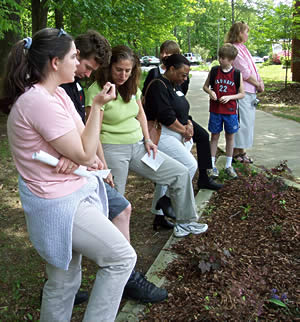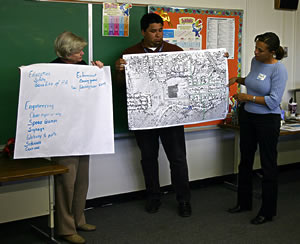

PBIC develops course to foster safer environments surrounding schools
Communities across the United States are taking the initiative to make walking and biking to school safer and more appealing. To better equip communities with the skills necessary to launch these programs, the Pedestrian and Bicycle Information Center (PBIC), has developed the Safe Routes to School (SR2S) National Course.

SR2S Course participants observe and document the drop-off area as school let out at Estes Hills Elementary School in Chapel Hill, NC. Participants then brainstormed and presented recommended improvements to the school’s principal.
With funding from the Federal Highway Administration, the National Highway Traffic Safety Administration, the Centers for Disease Control and Prevention and the Environmental Protection Agency, the PBIC developed the course with a clear intent to address relevant health, transportation and safety issues for community stakeholders – from city planners to parents – interested in improving walking and bicycling conditions for children.
Developing the content
The Center’s SR2S course development team was committed to providing information and opportunities for hands-on learning and discussion to help communities create sound programs to facilitate walking and biking, based on local conditions, best practices and responsible use of resources.
“In our work at the Center, we recognized that communities need to be given the information and tools to develop Safe Routes to School programs that have safety at their core,” said Charlie Zegeer, director of the Pedestrian and Bicycle Information Center. “Where it is safe, we want to get children walking and bicycling; where it is not, we want to make it safe.” In developing the course, the team stressed the importance of conveying overarching concepts with consideration for the specific needs of the community where the course was being implemented.
Because safe routes to school issues involve many disciplines, the course was designed to bring together individuals with different interests, including planning, engineering, education, law enforcement and public health as well as parents and others that care about kids walking and biking to school, and give them a shared knowledge base.
Once the initial course was developed, the PBIC pilot tested the course in 3 sites in Maryland and Virginia during September 2004. The team then made changes to the course based on feedback gained through written course evaluations, informal discussions with participants, and funder review.
Training the trainers
In order to make the course available and affordable to communities throughout the US, the PBIC trained 50 individuals from across the country. These individuals brought strong backgrounds in engineering, planning, education and public health, with experience in implementing SR2S programs as well as extensive presentation and training skills.

At the Safe Routes to School National Course in Tucson, small groups of participants brainstorm and present their ideas for walking and bicycling improvements.
Two instructor training sessions were held – one in Tucson, AZ and one in Chapel Hill, NC. During each five-day session, trainees observed course developers teaching the course and learned specific information about the rationale and methods for facilitating each course module. In addition, they then demonstrated their course delivery skills by teaching the course in local communities.
The course
Highlights of the course include a walking audit of a local school campus and surrounding area; strategies for incorporating encouragement, engineering. education and enforcement into walking improvements; as well as discussions on creating short and long-term action items for stakeholders. By the end of the day, participants have created a list of action steps and have individually made commitments to the role each will play as the program moves forward in their community.
Delivery of the course began through two mechanisms. 1. Instructor training participants have been teaching the course in their respective regions. 2. The PBIC is coordinating limited subsidized offerings of the course. Among the places receiving the course this spring are Richmond, VA, Chicago, IL, Glendale, AZ and Rochester, NY.
Next Steps
The PBIC is now working to promote the delivery of the course. Requests for fall courses are now being accepted. For more information, please visit the PBIC’s web site at http://www.pedbikeinfo.org/sr2s.
The University of North Carolina Highway Safety Research Center
730 Martin Luther King Jr. Blvd, Suite 300 | Campus Box 3430 | Chapel Hill, NC 27599-3430
Phone: 919.962.2203 | Fax: 919.962.8710
http://www.hsrc.unc.edu
